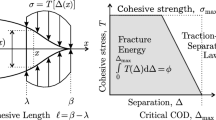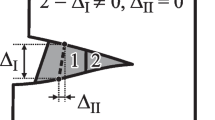Abstract
A new symmetric boundary integral formulation for cohesive cracks growing in the interior of homogeneous linear elastic isotropic media with a known crack path is developed and implemented in a numerical code. A crack path can be known due to some symmetry implications or the presence of a weak or bonded surface between two solids. The use of a two-dimensional exponential cohesive law and of a special technique for its inclusion in the symmetric Galerkin boundary element method allows us to develop a simple and efficient formulation and implementation of a cohesive zone model. This formulation is dependent on only one variable in the cohesive zone (relative displacement). The corresponding constitutive cohesive equations present a softening branch which induces to the problem a potential instability. The development and implementation of a suitable solution algorithm capable of following the growth of the cohesive zone and subsequent crack growth becomes an important issue. An arc-length control combined with a Newton–Raphson algorithm for iterative solution of nonlinear equations is developed. The boundary element method is very attractive for modeling cohesive crack problems as all nonlinearities are located along the boundaries (including the crack boundaries) of linear elastic domains. A Galerkin approximation scheme, applied to a suitable symmetric integral formulation, ensures an easy treatment of cracks in homogeneous media and excellent convergence behavior of the numerical solution. Numerical results for the wedge split and mixed-mode flexure tests are presented.
Similar content being viewed by others
References
Needleman A (1987) A continuum model for void nucleation by inclusion debonding. J Appl Mech-T ASME 54: 525–532
Camacho GT, Ortiz M (1996) Computational modelling of impact damage in brittle materials. Int J Solids Struct 33: 2899–2938
Ortiz M, Pandolfi A (1999) Finite-deformation irreversible cohesive elements for three dimensional crack propagation analysis. Int J Numer Meth Eng 44: 1267–1283
Xu XP, Needleman A (1993) Void nucleation by inclusion debonding in a crystal matrix. Model Simul Mater Sci 1: 111–132
Chandra N, Shet C (2004) A micromechanistic perspective of cohesive zone approach in modeling fracture. CMES-Comp Model Eng 5(1): 21–34
Bažant Z, Planas J (1998) Fracture and size effect in concrete and other quasibrittle materials. CRC Press LLC, Boca Raton
Barenblatt GI (1959) The formation of equilibrium cracks during brittle fracture. General ideas and hypotheses. Axially-symmetric cracks. PMM-J Appl Math Mech 23: 622–636
Hilleborg A, Modéer M, Petersson PE (1976) Analysis of a crack formation and crack growth in concrete by fracture mechanics and finite elements. Cement Concr Res 6: 773–782
Brebbia CA, Telles JCF, Wrobel LC (1984) Boundary element techniques. Springer, Berlin
París F, Cañas J (1997) Boundary element method, fundamentals and applications. Oxford University Press, Oxford
Bonnet M (1999) Boundary integral equation methods for solids and fluids. Wiley, Chichester
Aliabadi MH (2002) The boundary element method vol 2—aplications in solids and structures. Wiley, Chichester
Sutradhar A, Paulino G, Gray L (2008) Symmetric Galerkin boundary element method. Springer, Berlin
Bonnet M, Maier G, Polizzotto C (1998) Symmetric Galerkin boundary element method. ASME Appl Mech Rev 51(11): 669–704
Wang Z, Wu Q (1991) A new approach treating corners in boundary element method. In: Brebbia CA (ed) Boundary elements XIII. Springer, Berlin, pp 901–911
Mitra AK, Ingber MS (1993) A new multiple-node method to resolve the difficulties in the BIEM caused by corners and discontinuous boundary conditions. Int J Numer Meth Eng 36: 1735–1746
Rjasanow S, Steinbach O (2007) The fast solution of boundary integral equations. Springer, New York
Sauter SA, Schwab C (2011) Boundary element methods. Springer, Berlin
Gray LJ (1998) Evaluation of singular and hypersingular Galerkin boundary integrals: direct limits and symbolic computation. In: Sladek V, Sladek J (eds) Singular integrals in the boundary element method, advances in boundary elements. Computational Mechanics Publications, Southampton, pp 33–84
Kitey R, Phan AV, Tippur HV, Kaplan T (2006) Modeling of crack growth through particulate clusters in brittle matrix by symmetric-Galerkin boundary element method. Int J Fract 141(1): 11–25
Wriggers P (2002) Computational contact mechanics. Springer, Berlin
Fafard M, Massicotte B (1993) Geometrical interpretation of the arc-length method. Comput Struct 46: 603–615
Crisfield MA (1997) Non-linear finite element analysis of solids and structures, vol 2. Wiley, Chichester
Ragon SA, Gürdal Z, Watson LT (2002) A comparison of three algorithms for tracing nonlinear equilibrium paths of structural systems. Int J Solids Struct 39: 689–698
Mallardo V, Alessandri C (2004) Arc-length procedures with BEM in physically nonlinear problems. Eng Anal Bound Elem 28: 547–559
Mallardo V (2009) Integral equations and nonlocal damage theory: a numerical implementation using the BDEM. Int J Fract 157: 13–32
Yang B, Ravi-Chandar K (1998) A single-domain dual-boundary-element formulation incorporating a cohesive zone model for elastostatic cracks. Int J Fract 22: 381–391
Aliabadi MH, Saleh AL (1998) Fracture mechanics analysis of cracking in plain and reinforced concrete using boundary element method. Eng Fract Mech 93: 115–144
Saleh AL, Aliabadi MH (1995) Three-dimensional crack-growth simulation using BEM. Eng Fract Mech 51: 533–545
Maier G, Novati G, Cen Z (1993) Symmetric boundary element method for quasi-brittle fracture and frictional problems. Comput Mech 13: 74–89
Bolzon G, Fedele R, Maier G (2002) Parameter identification of a cohesive crack model by Kalman filter. Comput Method Appl Meach 13: 74–89
Maier G, Frangi A (1998) Symmetric boundary element method for “discrete” crack modelling of fracture processes. Comput Assist Mech Eng Sci 5: 201–226
Salvadori A (2003) A symmetric boundary integral formulation for cohesive interface problems. Comput Mech 22: 381–391
Távara L, Mantič V, Salvadori A, Gray LJ, París F (2010) SGBEM for cohesive cracks in homogeneous media. Key Eng Mater 454: 1–10
Rizzo FJ (1967) An integral equation approach to boundary value problems of classical elastostatics. Q Appl Math 25: 83–95
Cruse TA (1988) Boundary element analysis in computational fracture mechanics. Kluwer, Boston
Mantič V, París F (1997) Symmetry properties of the kernels of the hypersingular integral and the corresponding regularized integral in the 2D Somigliana stress identity for isotropic materials. Eng Anal Bound Elem 20: 163–168
Sirtori S (1979) General stress analysis method by means of integral equations and boundary elements. Meccanica 14: 210–218
Hartmann F, Katz C, Protopsaltis B (1985) Boundary elements and symmetry. Ingenieur-Archiv 55: 440–449
Maier G, Polizzotto C (1987) A Galerkin approach to boundary element elastoplastic analysis. Comput Method Appl Meach 60: 175–194
Maier G, Novati G, Sirtori S (1990) On symmetrization in boundary element elastic and elastoplastic analysis. In: Kuhn G, Mang H (eds) Discretization methods in structural mechanics. Springer, Berlin, pp 191–200
Sirtori S, Maier G, Novati G, Miccoli S (1992) A Galerkin symmetric boundary element method in elasticity: formulation and implementation. Int J Numer Meth Eng 35: 255–282
Maier G, Miccoli S, Novati G, Sirtori S (1993) A Galerkin symmetric boundary element method in plasticity: formulation and implementation. In: Kane JH, Maier G, Tosaka N, Atluri SN (eds) Advances in boundary element techniques. Springer, Berlin, pp 288–328
Salvadori A (2006) Numerical simulations of cohesive interface problems via boundary integral equations. Proceedings of IABEM 2006, Graz
Hölzer SM (1993) How to deal with hypersingular integrals in the symmetric BEM. Commun Numer Meth Eng 9: 219–232
Frangi A, Novati G (1996) Symmetric BE method in two-dimensional elasticity: evaluation of double integrals for curved elements. Comput Mech 19: 58–68
Nintcheu Fata S (2009) Explicit expressions for 3D boundary integrals in potential theory. Int J Numer Meth Eng 78(1): 32–47
Salvadori A (2010) Analytical integrations in 3D BEM for elliptic problems: evaluation and implementation. Int J Numer Meth Eng 84: 505–542
Salvadori A (2002) Analytical integrations in 2D BEM elasticity. Int J Numer Meth Eng 53(7): 1695–1719
Salvadori A, Gray L (2007) Analytical integrations and SIFs computation in 2D fracture mechanics. Int J Numer Meth Eng 70: 445–495
Phan AV (2012) A non-singular boundary integral formula for frequency domain analysis of the dynamic T-stress. Int J Fract 173(1): 37–48
Ruiz G, Pandolfi A, Ortiz M (2001) Three-dimensional cohesive modeling of dynamic mixed-mode fracture. Int J Numer Meth Eng 52: 97–120
Gray LJ, Paulino GH (1997) Symmetric Galerkin boundary integral fracture analysis for plane orthotropic elasticity. Comput Mech 20: 26–33
Zienkiewicz OC, Taylor RL (2000) The finite element method: the basis, vol 1, 5th edn. Oxford Press, Oxford
Remmers JC, Borst R, Needleman A (2008) The simulation of dynamic crack propagation using the cohesive segments method. J Mech Phys Solids 56: 70–92
Riks E (1979) An incremental approach to the solution of snapping and buckling problems. Int J Solids Struct 15: 529–551
Ramm E (1981) Strategies for tracing the non-linear response near limit-points. In: Wunderlich W, Stein E, Bathe KJ (eds) Non-linear finite element analysis in structural mechanics. Procededing European US workshop. Springer, Berlin
Denarié E, Saouma VE, Iocco A, Varelas D (2001) Concrete fracture process zone characterization with fiber optics. J Eng Mech-ASCE 127(5): 494–502
Valaroso N, Champaney L (2006) A damage-mechanics-based approach for modelling decohesion in adhesively bonded assemblies. Eng Fract Mech 73: 2774–2801
Vodička R, Mantič V, París F (2006) Note on the removal of rigid body motions in the solution of elastostatic traction boundary value problems by SGBEM. Eng Anal Bound Elem 30: 790–798
Blázquez A, Mantič V, París F, Cañas J (1996) On the removal of rigid body motions in the solution of elastostatic problems by direct BEM. Int J Numer Meth Eng 39: 4021–4038
Author information
Authors and Affiliations
Corresponding author
Rights and permissions
About this article
Cite this article
Távara, L., Mantič, V., Salvadori, A. et al. Cohesive-zone-model formulation and implementation using the symmetric Galerkin boundary element method for homogeneous solids. Comput Mech 51, 535–551 (2013). https://doi.org/10.1007/s00466-012-0808-5
Received:
Accepted:
Published:
Issue Date:
DOI: https://doi.org/10.1007/s00466-012-0808-5




